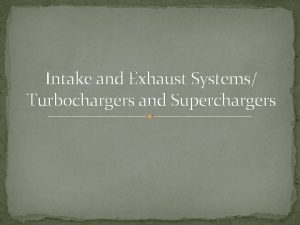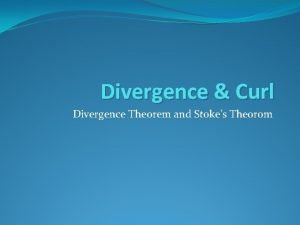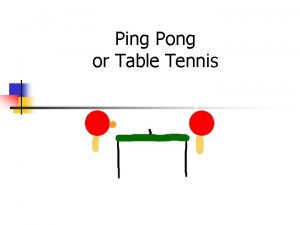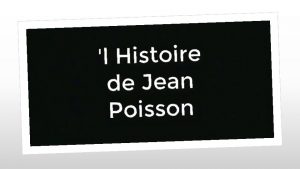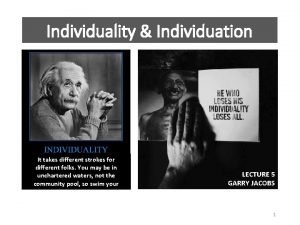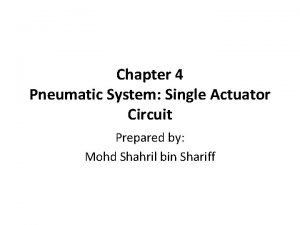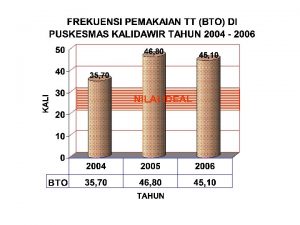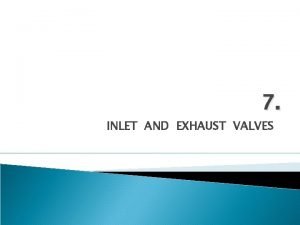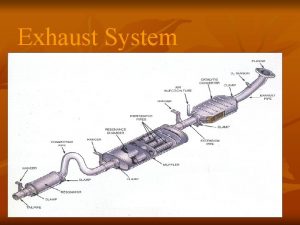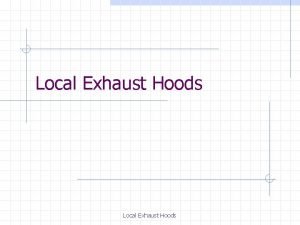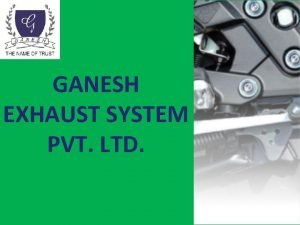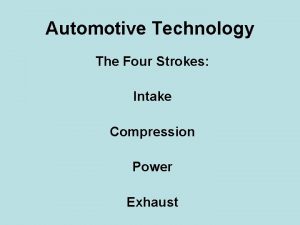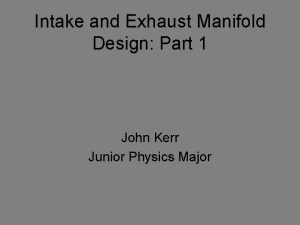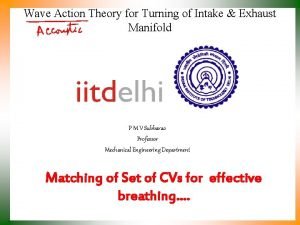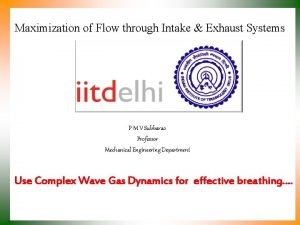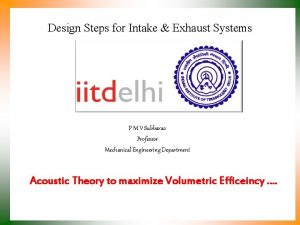Ideal Intake and Exhaust Strokes In the ideal












- Slides: 12

Ideal Intake and Exhaust Strokes In the ideal four-stroke cycle the exhaust process is modeled as constant volume heat extraction and does not consider the actual gas flow. Pressure, P At WOT the intake exhaust processes are often shown as a constant pressure processes, e. g. , 5 6 and 6 5 where states 1 and 5 are the same. EV closes IV opens IV closes EV opens Specific volume, v Process 5 -6 indicates a decrease in specific volume which is incorrect since as the cylinder volume decreases so does the mass specific volume remains the same! This inconsistency results from treating an open system problem with a closed system model

Valves operate instantaneously, intake and exhaust process are adiabatic and constant pressure. Unthrottled: Pi = Pe = 1 atm EV opens IV closes (state 1) EV closes IV opens Throttled: Pi < Pe EV opens EV closes IV closes 6’ IV opens Supercharged: Pi > Pe IV opens EV closes 6’ 1

Actual Exhaust Strokes The actual exhaust process consists of two phases: Pe Pi T i Products State 4 (BC) State 5 (BC) Blowdown State 6 (TC) Displacement Blowdown – At the end of the power stroke when the exhaust valve opens the cylinder pressure is much higher than the exhaust manifold pressure which is typically at 1 atm (P 4 > Pe), so the cylinder gas flows out through the exhaust valve and the pressure drops to Pe. Displacement – Remaining gas is pushed out of the cylinder by the piston moving to TC.

Blowdown • During the blowdown the gas remaining in the cylinder undergoes an isentropic expansion process (neglecting heat transfer) Blowdown Displacement 5 5 (Otto/Diesel) TC BC • State 5 at the end of blowdown is a fictitious state corresponding to no actual piston location

Residual Gas The gas remaining in the cylinder when the piston reaches TC is called residual gas which mixes with intake gas (fuel-air for SI and air for CI) The residual gas temperature T 6 is equal to T 5 The Residual gas fraction f is defined as the ratio of the mass of residual gas to the mass of the fuel-air (assume ideal gas Pv = RT) Typically values of f are in the range 3% to 12%, lower in Diesels (larger r)

Intake Stroke 6 1 When the intake valve opens the fresh gas with mass mi mixes with the hotter residual gas with mass m. R so the gas temperature at the end of the intake stroke T 1 will be greater than the inlet temperature Ti. Applying conservation of mass: Ti Applying conservation of energy (open system): 6

Intake Gas Temperature (T 1) Recall m 6 = m 1 f and assuming ideal gas P 6 v 6 = RT 6 and h = cp. T In terms of inlet and exhaust conditions P 1 = Pi , P 6 = Pe , T 6 = Te 7

Valve Overlap In real engines valves don’t open and close instantaneously. In order to ensure that the valve is fully open during a stroke for volumetric efficiency, the valves are open for longer than 180 o. The exhaust valve opens before TC and closes after BC and the intake valve opens before TC and closes after BC. At TC there is a period of valve overlap where both the intake and exhaust valves are open. 8

Valve overlap When the intake valve opens the cylinder pressure is at Pe Part throttle (Pi < Pe): residual gas flows into the intake port. During intake stroke the residual gas is first returned to the cylinder then fresh gas is introduced. Residual gas reduces part load performance. WOT (Pi = Pe): some fresh gas can flow out the exhaust valve reducing performance and increasing emissions. Supercharged (Pi > Pe): fresh gas can flow out the exhaust valve Pe Pi Throttled Pi < P e Pi Pe Supercharged Pi > P e 9

Valve Timing Conventional engines operate at low rpms, with idle and part load important High performance engines operate at high rpms at WOT, with power and volumetric efficiency important At high engine speeds less time available for fresh gas intake so need more crank angles to get high volumetric efficiency large valve overlap At low engine speed and part throttle valve overlap is minimized by reducing the angle duration for valves staying open. 10

Volumetric Efficiency Volumetric efficiency is affected by : i) Fuel evaporation ii) Mixture temperature iii) Pressure drop in the intake system iv) Gas dynamic effects Note: piston speed is proportional to air flow velocity

Factors affecting hv as a function of speed Fuel vapour pressure 12
 Intake and exhaust systems
Intake and exhaust systems Absolute brush stroke
Absolute brush stroke Appositive brush stroke
Appositive brush stroke Green theorem is relation between
Green theorem is relation between Recurrent stroke causes
Recurrent stroke causes Head strokes physical affection
Head strokes physical affection Theorom
Theorom They were as cannons overcharged with double cracks
They were as cannons overcharged with double cracks Types of offensive strokes in table tennis
Types of offensive strokes in table tennis Appositive brush stroke example
Appositive brush stroke example Transactionele analyse drivers
Transactionele analyse drivers It takes different strokes to rule the world
It takes different strokes to rule the world Supply air throttling system
Supply air throttling system
